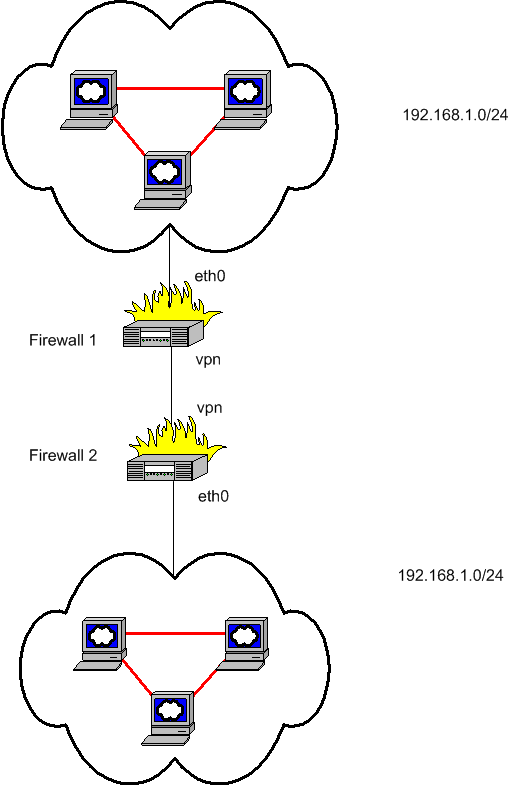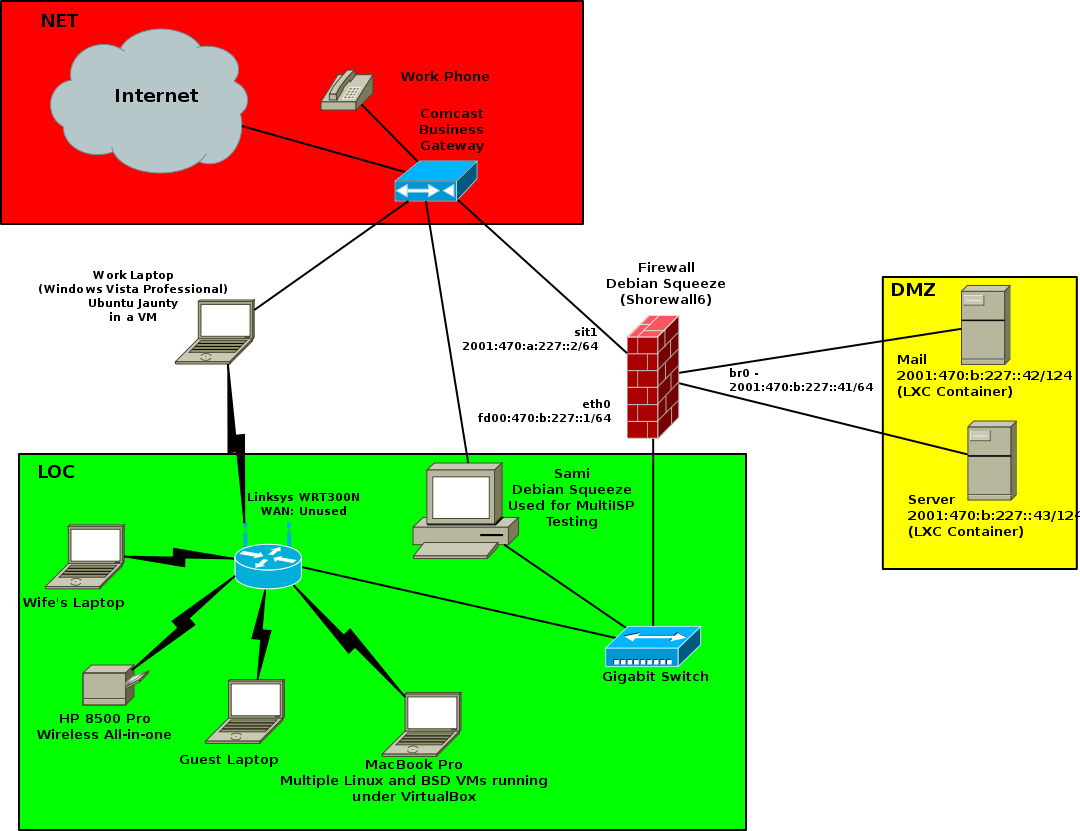Copyright © 2004-2005, 2007, 2011 Thomas M. Eastep
Permission is granted to copy, distribute and/or modify this document under the terms of the GNU Free Documentation License, Version 1.2 or any later version published by the Free Software Foundation; with no Invariant Sections, with no Front-Cover, and with no Back-Cover Texts. A copy of the license is included in the section entitled “GNU Free Documentation License”.
2020/04/17
Table of Contents
Network Mapping is most often used to resolve IP address conflicts. Suppose that two organizations, A and B, need to be linked and that both organizations have allocated the 192.168.1.0/24 subnetwork. There is a need to connect the two networks so that all systems in A can access the 192.168.1.0/24 network in B and vice versa without any re-addressing.
Shorewall NETMAP support is designed to supply a solution. The basic situation is as shown in the following diagram.

While the link between the two firewalls is shown here as a VPN, it could be any type of interconnection that allows routing of RFC 1918 traffic.
The systems in the top cloud will access the 192.168.1.0/24 subnet in the lower cloud using addresses in another unused /24. Similarly, the systems in the bottom cloud will access the 192.168.1.0/24 subnet in the upper cloud using a second unused /24.
In order to apply this solution:
You must be running Shorewall 2.0.1 Beta 2 or later.
Your kernel must have NETMAP support. 2.6 Kernels have NETMAP support without patching while 2.4 kernels must be patched using Patch-O-Matic from netfilter.org.
NETMAP support must be enabled in your kernel (CONFIG_IP_NF_TARGET_NETMAP=m or CONFIG_IP_NF_TARGET_NETMAP=y).
Your iptables must have NETMAP support. NETMAP support is available in iptables 1.2.9 and later.
Network mapping is defined using the
/etc/shorewall/netmap file. Columns in this file
are:
- TYPE
Must be DNAT or SNAT.
If DNAT, traffic entering INTERFACE and addressed to NET1 has its destination address rewritten to the corresponding address in NET2.
If SNAT, traffic leaving INTERFACE with a source address in NET1 has its source address rewritten to the corresponding address in NET2.
- NET1
Must be expressed in CIDR format (e.g., 192.168.1.0/24). Beginning with Shorewall 4.4.24, exclusion is supported.
- INTERFACE
A firewall interface. This interface must have been defined in
/etc/shorewall/interfaces.- NET2
A second network expressed in CIDR format.
- NET3 (Optional) - network-address
Added in Shorewall 4.4.11. If specified, qualifies INTERFACE. It specifies a SOURCE network for DNAT rules and a DESTINATON network for SNAT rules.
- PROTO (Optional - Added in Shorewall 4.4.23.2) - protocol-number-or-name
Only packets specifying this protocol will have their IP header modified.
- DPORT (Optional - Added in Shorewall 4.4.23.2) - port-number-or-name-list
Destination Ports. A comma-separated list of Port names (from services(5)), port numbers or port ranges; if the protocol is icmp, this column is interpreted as the destination icmp-type(s). ICMP types may be specified as a numeric type, a numberic type and code separated by a slash (e.g., 3/4), or a typename. See https://shorewall.org/configuration_file_basics.htm#ICMP.
If the protocol is ipp2p, this column is interpreted as an ipp2p option without the leading "--" (example bit for bit-torrent). If no PORT is given, ipp2p is assumed.
An entry in this field requires that the PROTO column specify icmp (1), tcp (6), udp (17), sctp (132) or udplite (136). Use '-' if any of the following field is supplied.
- SPORT (Optional - Added in Shorewall 4.4.23.2) - port-number-or-name-list
Source port(s). If omitted, any source port is acceptable. Specified as a comma-separated list of port names, port numbers or port ranges.
An entry in this field requires that the PROTO column specify tcp (6), udp (17), sctp (132) or udplite (136). Use '-' if any of the following fields is supplied.
Referring to the figure above, lets suppose that systems in the top cloud are going to access the 192.168.1.0/24 network in the bottom cloud using addresses in 10.10.10.0/24 and that systems in the bottom could will access 192.168.1.0/24 in the top could using addresses in 10.10.11.0.
Important
You must arrange for routing as follows:
Traffic from the top cloud to 10.10.10.0/24 must be routed to eth0 on firewall 1.
Firewall 1 must route traffic to 10.10.10.0/24 through firewall 2.
Traffic from the bottom cloud to 10.10.11.0/24 must be routed to eth0 on firewall 2.
Firewall 2 must route traffic to 10.10.11.0/24 through firewall 1.
The entries in
/etc/shorewall/netmap
#TYPE NET1 INTERFACE NET2 SNAT 192.168.1.0/24 vpn 10.10.11.0/24 #RULE 1A DNAT 10.10.11.0/24 vpn 192.168.1.0/24 #RULE 1B
The entry in /etc/shorewall/netmap in
firewall2 would be:
#TYPE NET1 INTERFACE NET2 DNAT 10.10.10.0/24 vpn 192.168.1.0/24 #RULE 2A SNAT 192.168.1.0/24 vpn 10.10.10.0/24 #RULE 2B
Example 1. 192.168.1.4 in the top cloud connects to 192.168.1.27 in the bottom cloud
In order to make this connection, the client attempts a
connection to 10.10.10.27. The following table shows how the source
and destination IP addresses are modified as requests are sent and
replies are returned. The RULE column refers to the above
/etc/shorewall/netmap entries and gives the rule
which transforms the source and destination IP addresses to those
shown on the next line.
| FROM | TO | SOURCE IP ADDRESS | DESTINATION IP ADDRESS | RULE |
|---|---|---|---|---|
| 192.168.1.4 in upper cloud | Firewall 1 | 192.168.1.4 | 10.10.10.27 | 1A |
| Firewall 1 | Firewall 2 | 10.10.11.4 | 10.10.10.27 | 2A |
| Firewall 2 | 192.168.1.27 in lower cloud | 10.10.11.4 | 192.168.1.27 | |
| 192.168.1.27 in the lower cloud | Firewall 2 | 192.168.1.27 | 10.10.11.4 | 2B |
| Firewall 2 | Firewall 1 | 10.10.10.27 | 10.10.11.4 | 1B |
| Firewall 1 | 192.168.1.4 in upper cloud | 10.10.10.27 | 192.168.1.4 |
See the OpenVPN documentation for a solution contributed by Nicola Moretti for resolving duplicate networks in a roadwarrior VPN environment.
Beginning with Shorewall 4.4.23, you can
bridge two duplicate networks with one router, provided that your kernel
and iptables include Rawpost Table Support. That
support is used to implement Stateless NAT which allows for performing
DNAT in the rawpost table POSTROUTING and OUTPUT chains and for
performing SNAT in the raw table PREROUTING chain. Using this support,
only firewall1 requires /etc/shorewall/netmap. Two
additional entries are added.
#TYPE NET1 INTERFACE NET2
SNAT 192.168.1.0/24 vpn 10.10.11.0/24
DNAT 10.10.11.0/24 vpn 192.168.1.0/24
SNAT:P 192.168.1.0/24 vpn 10.10.10.0/24
DNAT:T 10.10.10.0/24 vpn 192.168.1.0/24The last two entries define Stateless NAT by specifying a chain designator (:P for PREROUTING and :T for POSTROUTING respectively). See shorewall-netmap (5) for details.
Beginning with Shorewall6 4.4.24, IPv6 support for Netmap is included. This provides a way to use private IPv6 addresses internally and still have access to the IPv6 internet.
Warning
IPv6 netmap is stateless which means that there are no Netfilter helpers for applications that need them. As a consequence, applications that require a helper (FTP, IRC, etc.) may experience issues.
For IPv6, the chain designator (:P for PREROUTING or :T for POSTROUTING) is required in the TYPE column. Normally SNAT rules are placed in the POSTROUTING chain while DNAT rules are placed in PREROUTING.
To use IPv6 Netmap, your kernel and iptables must include Rawpost Table Support.
IPv6 Netmap has been verified at shorewall.net using the configuration shown below.

IPv6 support is supplied from Hurricane Electric; the IPv6 address block is 2001:470:b:227::/64.
Because of the limitations of IPv6 NETMAP (no Netfilter helpers), the servers in the DMZ have public addresses in the block 2001:470:b:227::/112. The local LAN uses the private network fd00:470:b:227::/64 with the hosts autoconfigured using radvd. This block is allocated from the range (fc00::/7) reserved for Unique Local Addresses.
The /etc/shorewall6/netmap file is as follows:
#TYPE NET1 INTERFACE NET2 NET3 PROTO DEST SOURCE # PORT(S) PORT(S) SNAT:T fd00:470:b:227::/64 HE_IF 2001:470:b:227::/64 DNAT:P 2001:470:b:227::/64!2001:470:b:227::/112\ HE_IF fd00:470:b:227::/64
HE_IF is the logical name for interface sit1. On output, the private address block is mapped to the public block. Because autoconfiguration is used, none of the local addresses falls into the range fd00:470:b:227::/112. That range can therefore be excluded from DNAT.
Note
While the site local network that was used is very similar to the public network (only the first word is different), that isn't a requirement. We could have just as well used fd00:bad:dead:beef::/64
Note
The MacBook Pro running OS X Lion refused to autoconfigure when radvd advertised a site-local network (fec0:470:b:227/64) but worked fine with the unique-local network (fd00:470:b:227::/64). Note that site-local addresses were deprecated in RFC3879.
Note
This whole scheme isn't quite as useful as it might appear. Many IPv6-enabled applications (web browsers, for example) are smart enough to recognize unique local addresses and will only use IPv6 to communicate with other such local addresses.

